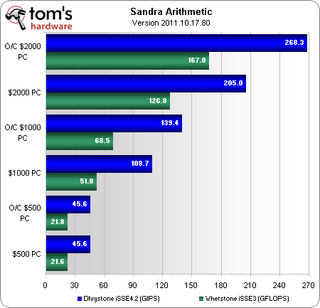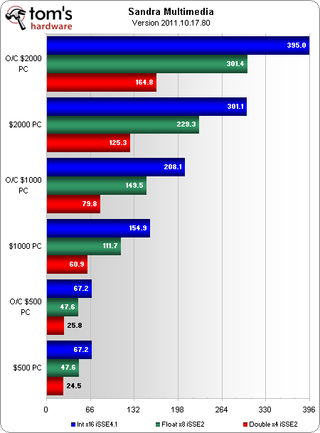System Builder Marathon, August 2012: System Value Compared
Benchmark Results: SiSoftware Sandra

So many of our tests are either single-threaded or scale modestly on multi-core processors that SiSoftware's Sandra diagnostic is needed just to demonstrate the potential of high-end CPUs with advanced ISA extensions that aren't yet exploited in real-world apps.
Although transcoding and productivity apps do help justify the purchase of six-core CPUs like my Core i7-3930K, in reality, you'd expect to find that chip in a workstation, rather than a desktop.


We knew that the $2000 PC would demonstrate phenomenal leadership in Sandra's Arithmetic and Multimedia modules, but we hadn't considered just how far Paul's $500 build would appear on the ladder. It's more than 50% slower than Don's setup, so we're almost scared to think how it'll compare when it comes time to discuss value.

A quad-channel memory controller looks impressive when you measure out the throughput available to Intel's Sandy Bridge-E architecture. Might my $2000 build even get a small advantage in the real-world tests as a result?
We’re also hoping that the $500 PC’s mediocre memory bandwidth can help it achieve at least 50% of the $1000 PC’s performance, if only to make our value comparison more interesting.
Stay on the Cutting Edge
Join the experts who read Tom's Hardware for the inside track on enthusiast PC tech news — and have for over 25 years. We'll send breaking news and in-depth reviews of CPUs, GPUs, AI, maker hardware and more straight to your inbox.
Current page: Benchmark Results: SiSoftware Sandra
Prev Page Benchmark Results: 3DMark And PCMark Next Page Benchmark Results: Battlefield 3-
abitoms The statistician (really) in me wonders wat might have happened to the $500 system's value if a quad FX was used in it...Reply
I mean swapping the G860 for a FX 4100 and a Radeon 7770 *might'* have provided an interesting contrast to the above $500 system.
Productivity up by 20% and games down by 20% I guess. Can only speculate.
Btw, thanks crashman for the tip.
This is just me wondering aloud. So...dunno why the thumbs down -
Crashman abitomsdamn,.... thought there was an Edit button somewhere.(sorry)So adding to my prev comment, swapping the G860 for a FX 4100 and a Radeon 7770 *might'* have provided an interesting contrast to the above $500 system.Above your first post there's a link "Read the comments in the forums". In the forums you can quick edit (on the view pane) or full edit (on a new page), and in full edit mode you can even delete your second post. That is, if you add the missing information the the first post.Reply -
mayankleoboy1 Since the benchmarks give a fair weight to the 'pro' applications, GPGPU benchmarks should be there as well.Reply
And those gaming benchmarks are ridiculous. Most are getting FPS in the 100+ range. So really, there is no comparison between the systems. all values above 60 are the same. How can 150 FPS be better than 120FPS on a 60HZ monitor? -
Crashman mayankleoboy1How can 150 FPS be better than 120FPS on a 60HZ monitor?Hopefully it will go along with a maximum frame time drop from 500ms to 50ms :)Reply
-
I know it's probably hard to do, but it would be awesome if Tom's could find out the price where price/performance is optimal instead of searching for the optimal build for a set price.Reply
-
frihyland Great article, seems like it might be time to switch up the price points for your builds though. $600, $1200, and $1800 seem much more reasonable and would give us better comparisons I think.Reply
Edit: Ninja'd by chmr -
perishedinflames frihylandGreat article, seems like it might be time to switch up the price points for your builds though. $600, $1200, and $1800 seem much more reasonable and would give us better comparisons I think.Edit: Ninja'd by chmrReply
current price-tags feel awkward i have to agree.
to be more specific:
a. Entry level gaming pc ($500): you try to pick the cheapest parts so that you save for the best GPU the rest of your money can buy
b. Enthusiast gaming pc ($1000): how most people try to build, save here and there (either by finding good deals or by dropping quality in RAM and Chassis mostly) so that you can get an awesome CPU & GPU (prolly a SSD too)
c. Hardcore gaming pc ($2000): the tag is too high so you just blindly buy the most expensive parts (like a sheikh on vacation)
what would show more accurate results might be one of the following two:
1. two builds; one of $700-$800 and one of around $1500 (+/- $100)
2. three builds again but with some $150-$200 offset; entry-lvl 650-700, enthusiast 1200-1400, hardcore 1700-1900
-
noob2222 abitomsThe statistician (really) in me wonders wat might have happened to the $500 system's value if a quad FX was used in it...I mean swapping the G860 for a FX 4100 and a Radeon 7770 *might'* have provided an interesting contrast to the above $500 system.Productivity up by 20% and games down by 20% I guess. Can only speculate.Btw, thanks crashman for the tip.This is just me wondering aloud. So...dunno why the thumbs downToms did a bunch of game reviews showing how bad AMD is so they don't have to use them for the SBM articles. 11 of the past 12 SBM have all been Intel, and the one AMD was bugged with a cheap cpu.Reply
Even though SBM was I thought to test hardware with different components, apparently as long as its only with Intel.
BF3 as a test needs to be done online, wether its controlled or not, you can at least get a feel of how its going to work. Especially with a dual core cpu. -
Crashman noob2222Toms did a bunch of game reviews showing how bad AMD is so they don't have to use them for the SBM articles.Nice conspiracy theory, but I'm not party to it. So, go back to bugging the $500 and $1000 PC builders. They must know something I don't.Reply
Most Popular


